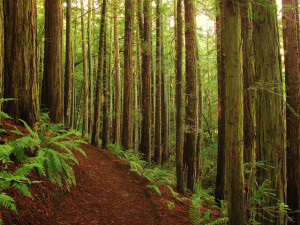The classic image of a redwood forest is one of stately tall trees, dense shade, and lots of green. The columnar trunks of the giant trees draw our gaze up to the high canopy, but if we follow them down to the forest floor instead, in summer months we may find unexpected points of brilliant color. These are the colorful fruits (mostly berries) of the smaller plants that live in the shelter of the big trees.
Some of the berries can be found in the shadiest depths of the forest, while others grow and thrive where more light penetrates: along creeks, in openings created by fallen trees, and near forest edges where light and plant diversity increase.
For the birds and small mammals that feed in the redwood forest, the bright colors of these berries are beacons announcing their ripeness in the shady groves. And for the plants, the berry-eating animals are vehicles for dispersing their seed to colonize new locations. Although consumed by wild animals, most of these fruits, with a few notable exceptions, are either unpalatable or outright toxic to humans.
Baneberry (Actaea rubra) has shiny red berries whose attractiveness belies their toxicity; the common name makes reference to a potent poison concentrated in the fruits. Another plant with beautiful but poisonous fruits is the blue bead lily (Clintonia andrewsiana), which has almost unbelievably bright metallic blue berries. Hooker’s fairy bell (Disporum hookeri) has potentially poisonous but eye-catching red-orange rounded fruits that cluster at the ends of its arching stems. Balancing out those toxic plants is the evergreen huckleberry (Vaccinium ovatum), which produces small, edible berries that turn from green to red to purple-black, ripening to sweet-tart perfection in late summer through early fall. (Remember, berry collecting is not permitted in parks.)
Though not abundant, all of the lovely fruits of the forest are worth watching for when you’re enjoying the shade and coolness of our local redwood groves in the summer months.

.jpg)

-300x200.jpg)
-300x201.jpg)